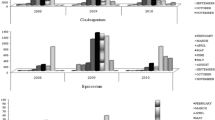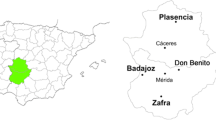Abstract
Because fungal spore emission intensity varies throughout the year and even throughout the day, study of the hourly distribution is an important aspect of aerobiological monitoring. The objective of this work was to determine seasonal and intradiurnal variation of allergenic airborne fungal spores in urban and rural areas. The aerobiological study was performed from 2005 to 2007 using Hirst-type volumetric spore traps. Fungal spore types (Cladosporium, Alternaria, and Aspergillus/Penicillium) were selected according to their allergenic capacity and their frequency in the atmosphere. Cladosporium was the most frequent fungal spore in both locations, together with Alternaria; its concentration was higher during summer whereas Aspergillus/Penicillium was more abundant during autumn. Alternaria and Cladosporium maximum daily spore concentration was reached from 16.00 to 20.00 h. Aspergillus/Penicillium spore distribution differed in the two locations, and although it was difficult to establish a distribution pattern the highest concentration were found during the night. Determination of periods of high concentration may help allergic patients to avoid the daily periods when the allergen concentration is highest.







Similar content being viewed by others
References
Anderssen, M., Downs, S., Mitakakis, T., Leuppi, J., & Marks, G. (2003). Natural exposure to Alternaria spores induces allergic rhinitis symptoms in sensitized children. Pediatric Allergy & Immunology, 14, 100–105. doi:10.1034/j.1399-3038.2003.00031.x.
Angulo-Romero, J., Mediavilla-Molina, A., & Domínguez-Vilches, E. (1999). Conidia of Alternaria in the atmosphere of the city of Cordoba, Spain in relation to meteorological parameters. International Archives of Allergy and Immunology, 43, 45–49.
Antico, A. (2004). Environmental factors and allergic airway diseases. Aerobiologia, 16, 321–326. doi:10.1023/A:1026514624659.
Black, P., Udy, A., & Brodie, S. (2000). Sensitivity to fungal allergens is a risk factor for life-threatening asthma. Allergy, 55, 501–504. doi:10.1034/j.1398-9995.2000.00293.x.
Bruno, A., Pace, L., Tomassetti, B., Coppola, E., Verdecchia, M., Pacioni, G., et al. (2007). Estimation of fungal spore concentrations associated to meteorological variables. Aerobiologia, 23, 221–228. doi:10.1007/s10453-007-9066-y.
Burch, M., & Levetin, E. (2002). Effects of meteorological conditions on spore plumes. International Archives of Allergy and Immunology, 46, 107–117.
Bush, R. K., & Prochnau, J. J. (2004). Alternaria-induced asthma. The Journal of Allergy and Clinical Immunology, 113, 227–234. doi:10.1016/j.jaci.2003.11.023.
Calderón, C., Lacey, J., McCartney, A., & Rosas, I. (1997). Influence of urban climate upon distribution of airborne Deuteromycete spore concentrations in Mexico City. International Journal of Biometeorology, 40(2), 71–80.
Cariñanos, P., Galan, C., Alcazar, P., & Dominguez, E. (1999). Diurnal variation of biological and non-biological particles in the atmosphere of Cordoba, Spain. Aerobiologia, 15, 177–182. doi:10.1023/A:1007590023585.
Corden, J., & Millington, W. (2001). The long-term trends and seasonal variation of the aeroallergen Alternaria in Derby, UK. Aerobiologia, 17, 127–136. doi:10.1023/A:1010876917512.
D’Amato, G. (2002). Environmental urban factors (air pollution and allergens) and the rising trends in allergic respiratory diseases. Allergy, 57, 30–33. doi:10.1034/j.1398-9995.57.s72.5.x.
D’Amato, G., & Liccardi, G. (2002). The increasing trend of seasonal respiratory allergy in urban areas. Allergy, 57, 35–36. doi:10.1034/j.1398-9995.2002.057s71035.x.
D’Amato, G., Liccardi, G., D’Amato, M., & Cazzola, M. (2002). Outdoor air pollution, climatic changes and allergic bronchial asthma. The European Respiratory Journal, 20, 763–776. doi:10.1183/09031936.02.00401402.
Damialis, A., & Gioulekas, D. (2006). Airborne allergenic fungal spores and meteorological factors in Greece: Forecasting possibilities. Grana, 45, 122–129. doi:10.1080/00173130600601005.
Denning, D. W., O’Driscoll, B. R., Hogaboam, C. M., Bowyer, P., & Niven, R. M. (2006). The link between fungi and severe asthma: A summary of the evidence. The European Respiratory Journal, 27, 615–626. doi:10.1183/09031936.06.00074705.
Dixit, A., Lewis, W., Baty, J., Crozier, W., & Wedner, J. (2000). Deuteromycete aerobiology and skin-reactivity patterns: A two year concurrent study in Corpus Christi, Texas, USA. Grana, 39, 209–218. doi:10.1080/00173130051084368.
Galán, C., Tormo, R., Cuevas, J., Infante, F., & Domínguez, E. (1991). Theoretical daily variation patterns of airborne pollen in the southwest of Spain. Grana, 30, 201–209.
Gershwin, L. J. (2003). Effects of air pollutants on development of allergic immune responses in the respiratory tract. Clinical & Developmental Immunology, 10, 119–126. doi:10.1080/10446670310001626535.
Gillum, S., & Levetin, E. (2008). The air spora close to a compost facility in Northeast Oklahoma: Part I—spore trap sampling. Aerobiologia, 24, 3–12. doi:10.1007/s10453-007-9074-y.
Giner, M., Garcia, J., & Camacho, C. (2001). Airborne Alternaria spores in SE Spain (1993–98): Occurrence patterns, relationship with weather variables and prediction models. Grana, 40, 111–118. doi:10.1080/00173130152625842.
Gravesen, S. (1979). Fungi as a cause of allergic disease. Allergy, 34, 135–154. doi:10.1111/j.1398-9995.1979.tb01562.x.
Grinn-Gofron, A., & Mika, A. (2008). Selected airborne allergenic fungal spores and meteorological factors in Szczecin, Poland, 2004–2006. Aerobiologia, 24, 89–97. doi:10.1007/s10453-008-9088-0.
Guinea, J., Peláez, T., Alcalá, L., & Bouza, E. (2006). Outdoor environmental levels of Aspergillus spp. conidia over a wide geographical area. Medical Mycology, 44, 349–356. doi:10.1080/13693780500488939.
Hasnain, S. M., Fatima, K., Al-Frayh, A., & Al-Sedairy, S. T. (2005). One-year pollen and spore calendars of Saudi Arabia: Al-Khobar, Abha and Hofuf. Aerobiologia, 21, 241–247. doi:10.1007/s10453-005-9000-0.
Henriquez, V., Villegas, G., & Nolla, J. (2001). Airborne fungi monitoring in Santiago, Chile. Aerobiologia, 17, 137–142. doi:10.1023/A:1010833101583.
Herrero, A., Ruiz, S., Bustillo, M., & Morales, P. (2006). Study of airborne fungal spores in Madrid, Spain. Aerobiologia, 22, 133–140. doi:10.1007/s10453-006-9025-z.
Jaakkola, M., Ieromnimon, A., & Jaakkola, J. (2006). Are atopy and specific IgE to mites and molds important for adult asthma? The Journal of Allergy and Clinical Immunology, 117, 642–648. doi:10.1016/j.jaci.2005.11.003.
Karihaloo, C., Tovey, E., Mitakakis, T., Duffy, D., & Britton, W. (2002). Evidence for the genetic control of immunoglobulin E reactivity to the allergens of Alternaria alternata. Clinical and Experimental Allergy, 32, 1316–1322. doi:10.1046/j.1365-2745.2002.01447.x.
Kasprzyk, I., & Worek, M. (2006). Airborne fungal spores in urban and rural environments in Poland. Aerobiologia, 22, 169–176. doi:10.1007/s10453-006-9029-8.
Konopinska, A. (2004). Monitoring of Alternaria ness and Cladosporium link in airborne spores in Lublin (Poland) in 2002. Annals of Agricultural and Environmental Medicine, 11, 347–349.
Kurup, V., Shen, H., & Banerjee, B. (2000). Respiratory fungal allergy. Microbes and Infection, 2, 1101–1110. doi:10.1016/S1286-4579(00)01264-8.
Kurup, V., Shen, H., & Vijay, H. (2002). Immunobiology of fungal allergens. International Archives of Allergy and Immunology, 129, 181–188. doi:10.1159/000066780.
Lacey, M. E., & West, J. S. (2006). The air spora. Dordrecht: Springer.
Liccardi, G., Custovic, A., Cazzola, M., Russo, M., D’Amato, M., & D’Amato, G. (2001). Avoidance of allergens and air pollutants in respiratory allergy. Allergy, 56, 705–722. doi:10.1034/j.1398-9995.2001.056008705.x.
Millington, W., & Corden, J. (2005). Long term trends in outdoor Aspergillus/Penicillium spore concentration in Derby, UK from 1970 to 2003 and a comparative study in 1994 and 1996 with indoor air of two local houses. Aerobiologia, 21, 105–113. doi:10.1007/s10453-005-4180-1.
Mitakakis, T., & Guest, D. (2001). A fungal spore calendar for the atmosphere of Melbourne, Australia, for the year 1993. Aerobiologia, 17, 171–176. doi:10.1023/A:1011028412526.
Mitakakis, T., & McGee, P. (2000). Reliability of measures of spores of Alternaria and pollen concentrations in air over two towns in rural Australia: Multiple sites for Burkard sampling. Grana, 39, 141–145. doi:10.1080/001731300300045300.
Moss, R. (2005). Pathophysiology and immunology of allergic bronchopulmonary aspergillosis. Medical Mycology, 43, S203–S206. doi:10.1080/13693780500052255.
Mullins, J., Hutcheson, P., & Slavin, R. (1984). Aspergillus fumigatus spore concentration in outside air: Cardiff and St Louis compared. Clinical and Experimental Allergy, 14, 351–354. doi:10.1111/j.1365-2222.1984.tb02215.x.
Myszkowska, D., Stepalska, D., Obtulowicz, K., & Porebski, G. (2002). The relationship between airborne pollen and fungal spore concentrations and seasonal pollen allergy symptoms in Cracow in 1997–1999. Aerobiologia, 18, 153–161. doi:10.1023/A:1020603717191.
Nicolaou, N., Siddique, N., & Custovic, A. (2005). Allergic disease in urban and rural populations: Increasing prevalence with increasing urbanization. Allergy, 60, 1357–1360. doi:10.1111/j.1398-9995.2005.00961.x.
Nilsson, S. (1983). Atlas of airborne fungal spores in Europe. Heidelberg: Springer-Verlag.
Oliveira, M., Ribeiro, H., & Abreu, I. (2005). Annual variation of fungal spores in the atmosphere of Porto: 2003. Annals of Agricultural and Environmental Medicine, 12, 309–315.
Oliveira, M., Ribeiro, H., Delgado, J. L., & Abreu, I. (2009). The effects of meteorological factors on airborne fungal spore concentration in two areas with different urbanization level. International Journal of Biometeorology, 53, 61–73. doi:10.1007/s00484-008-0191-2.
Pepeljnjak, S., & Segvi, M. (2003). Occurrence of fungi in air and on plants in vegetation of different climatic regions in Croatia. Aerobiologia, 19, 11–19. doi:10.1023/A:1022693032075.
Peternel, R., Culig, J., & Hrga, I. (2004). Atmospheric concentrations of Cladosporium spp. and Alternaria spp. spores in Zagreb (Croatia) and effects of some meteorological factors. Annals of Agricultural and Environmental Medicine, 11, 303–307.
Ribeiro, H., Oliveira, M., & Abreu, I. (2008). Intradiurnal variation of allergenic pollen in the city of Porto (Portugal). Aerobiologia, 24, 173–177. doi:10.1007/s10453-008-9091-5.
Rosas, I., Calderon, C., Ulloa, M., & Lacey, J. (1993). Abundance of airborne Penicillium CFU in relation to urbanization in Mexico city. Applied and Environmental Microbiology, 58, 2648–2652.
Rosas, I., Escamilla, B., Calderon, C., & Mosiño, P. (1990). The daily variations of airborne fungal spores in Mexico city. Aerobiologia, 6, 153–158. doi:10.1007/BF02539108.
Sabariego Ruiz, S., de la Guardia Guerrero, C. D., & Alba Sânchez, F. (2004). Estudio aerobiológico de los conidios de Alternaria y Cladosporium en la atmósfera de la ciudad de Almeria (SE de Espana). Revista Iberoamericana de Micologia, 21, 121–127.
Simeray, J., Chaumont, J.-P., & Leger, D. (1993). Seasonal variations in the airborne fungal spore population of the east of France (Franche–Comte). Comparison between urban and rural environment during two years. Aerobiologia, 9, 201–206. doi:10.1007/BF02066263.
Simon-Nobbe, B., Denk, U., Pöll, V., Rid, R., & Breitenbach, M. (2008). The spectrum of fungal allergy. International Archives of Allergy and Immunology, 145, 58–86. doi:10.1159/000107578.
Stark, P. C., Celedon, J. C., Chew, G. L., Ryan, L. M., Burge, H. A., Muilenberg, M. L., et al. (2005). Fungal levels in the home and allergic rhinitis by 5 years of age. Environmental Health Perspectives, 113, 1405–1409.
Troutt, C., & Levetin, E. (2001). Correlation of spring spore concentrations and meteorological conditions in Tulsa, Oklahoma. International Journal of Biometeorology, 45, 64–74. doi:10.1007/s004840100087.
Zureik, M., Neukirch, C., Leynaert, B., Liard, R., Bousquet, J., & Neukirch, F. (2002). Sensitisation to airborne moulds and severity of asthma: Cross sectional study from European community respiratory health survey. BMJ (Clinical Research Ed.), 325, 411. doi:10.1136/bmj.325.7361.411.
Acknowledgments
This work was partially supported by the Fundação Calouste Gulbenkian (project: 77161) and a grant from the Fundação para a Ciência e Tecnologia (SFRH/BD/18765/2004).
Author information
Authors and Affiliations
Corresponding author
Rights and permissions
About this article
Cite this article
Oliveira, M., Ribeiro, H., Delgado, J.L. et al. Seasonal and intradiurnal variation of allergenic fungal spores in urban and rural areas of the North of Portugal. Aerobiologia 25, 85–98 (2009). https://doi.org/10.1007/s10453-009-9112-z
Received:
Accepted:
Published:
Issue Date:
DOI: https://doi.org/10.1007/s10453-009-9112-z




